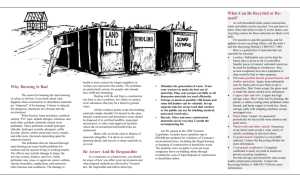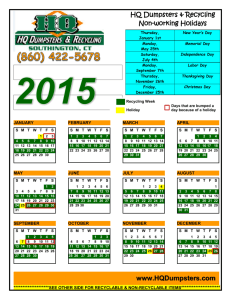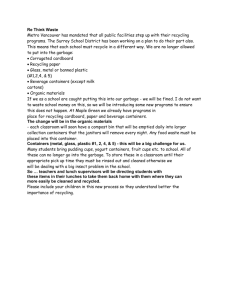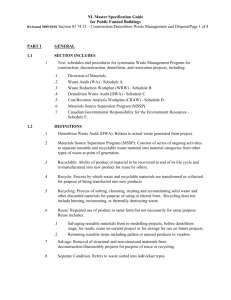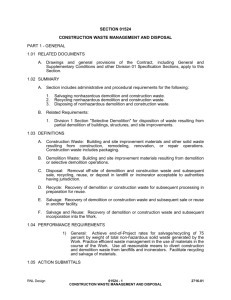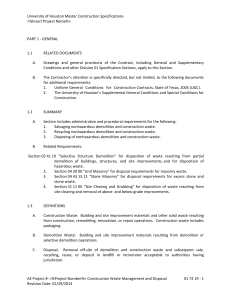017419 Construction Waste Management
advertisement
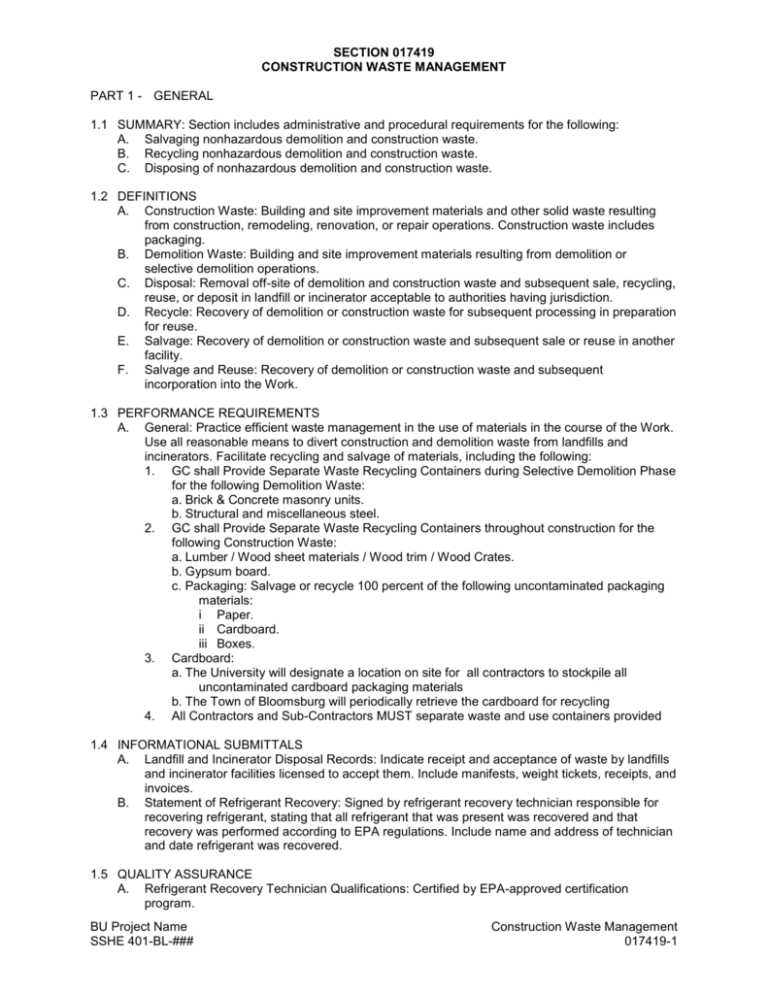
SECTION 017419 CONSTRUCTION WASTE MANAGEMENT PART 1 - GENERAL 1.1 SUMMARY: Section includes administrative and procedural requirements for the following: A. Salvaging nonhazardous demolition and construction waste. B. Recycling nonhazardous demolition and construction waste. C. Disposing of nonhazardous demolition and construction waste. 1.2 DEFINITIONS A. Construction Waste: Building and site improvement materials and other solid waste resulting from construction, remodeling, renovation, or repair operations. Construction waste includes packaging. B. Demolition Waste: Building and site improvement materials resulting from demolition or selective demolition operations. C. Disposal: Removal off-site of demolition and construction waste and subsequent sale, recycling, reuse, or deposit in landfill or incinerator acceptable to authorities having jurisdiction. D. Recycle: Recovery of demolition or construction waste for subsequent processing in preparation for reuse. E. Salvage: Recovery of demolition or construction waste and subsequent sale or reuse in another facility. F. Salvage and Reuse: Recovery of demolition or construction waste and subsequent incorporation into the Work. 1.3 PERFORMANCE REQUIREMENTS A. General: Practice efficient waste management in the use of materials in the course of the Work. Use all reasonable means to divert construction and demolition waste from landfills and incinerators. Facilitate recycling and salvage of materials, including the following: 1. GC shall Provide Separate Waste Recycling Containers during Selective Demolition Phase for the following Demolition Waste: a. Brick & Concrete masonry units. b. Structural and miscellaneous steel. 2. GC shall Provide Separate Waste Recycling Containers throughout construction for the following Construction Waste: a. Lumber / Wood sheet materials / Wood trim / Wood Crates. b. Gypsum board. c. Packaging: Salvage or recycle 100 percent of the following uncontaminated packaging materials: i Paper. ii Cardboard. iii Boxes. 3. Cardboard: a. The University will designate a location on site for all contractors to stockpile all uncontaminated cardboard packaging materials b. The Town of Bloomsburg will periodically retrieve the cardboard for recycling 4. All Contractors and Sub-Contractors MUST separate waste and use containers provided 1.4 INFORMATIONAL SUBMITTALS A. Landfill and Incinerator Disposal Records: Indicate receipt and acceptance of waste by landfills and incinerator facilities licensed to accept them. Include manifests, weight tickets, receipts, and invoices. B. Statement of Refrigerant Recovery: Signed by refrigerant recovery technician responsible for recovering refrigerant, stating that all refrigerant that was present was recovered and that recovery was performed according to EPA regulations. Include name and address of technician and date refrigerant was recovered. 1.5 QUALITY ASSURANCE A. Refrigerant Recovery Technician Qualifications: Certified by EPA-approved certification program. BU Project Name SSHE 401-BL-### Construction Waste Management 017419-1 B. Regulatory Requirements: Comply with hauling and disposal regulations of authorities having jurisdiction. PART 2 - PRODUCTS (Not Applicable) PART 3 - EXECUTION 3.1 WASTE MANAGEMENT IMPLEMENTATION A. General: Provide handling, containers, storage, signage, transportation, and other items as required during the entire duration of the Contract. B. Training: Train workers, subcontractors, and suppliers on proper waste management procedures, as appropriate for the Work. C. Site Access and Temporary Controls: Conduct waste management operations to ensure minimum interference with roads, streets, walks, walkways, and other adjacent occupied and used facilities. 1. Designate and label specific areas on Project site necessary for separating materials that are to be salvaged, recycled, reused, donated, and sold. 2. Comply with Section 015000 "Temporary Facilities and Controls" for controlling dust and dirt, environmental protection, and noise control. 3.2 SALVAGING DEMOLITION WASTE A. Salvaged Items for Reuse in the Work: Salvage items for reuse and handle as follows: 1. Clean salvaged items. 2. Pack or crate items after cleaning. Identify contents of containers with label indicating elements, date of removal, quantity, and location where removed. 3. Store items in a secure area until installation. 4. Protect items from damage during transport and storage. 5. Install salvaged items to comply with installation requirements for new materials and equipment. Provide connections, supports, and miscellaneous materials necessary to make items functional for use indicated. B. Salvaged Items for Sale and Donation: Not permitted on Project site. C. Salvaged Items for Owner's Use: Salvage items for Owner's use and handle as follows: 1. Clean salvaged items. 2. Pack or crate items after cleaning. Identify contents of containers with label indicating elements, date of removal, quantity, and location where removed. 3. Store items in a secure area until delivery to Owner. 4. Transport items to Owner's storage area designated by Owner. 5. Protect items from damage during transport and storage. D. Doors and Hardware: Brace open end of door frames. Except for removing door closers, leave door hardware attached to doors. E. Equipment: Drain tanks, piping, and fixtures. Seal openings with caps or plugs. Protect equipment from exposure to weather. F. Plumbing Fixtures: Separate by type and size. G. Lighting Fixtures: Separate lamps by type and protect from breakage. H. Electrical Devices: Separate switches, receptacles, switchgear, transformers, meters, panelboards, circuit breakers, and other devices by type. 3.3 RECYCLING DEMOLITION AND CONSTRUCTION WASTE, GENERAL A. General: Recycle paper and beverage containers used by on-site workers. B. Recycling Incentives: Revenues, savings, rebates, tax credits, and other incentives received for recycling waste materials shall accrue to General Contractor. C. Preparation of Waste: Prepare and maintain recyclable waste materials according to recycling or reuse facility requirements. Maintain materials free of dirt, adhesives, solvents, petroleum contamination, and other substances deleterious to the recycling process. D. Procedures: Separate recyclable waste from other waste materials, trash, and debris. Separate recyclable waste by type at Project site to the maximum extent practical according to approved construction waste management plan. 1. Provide appropriately marked containers or bins for controlling recyclable waste until removed from Project site. Include list of acceptable and unacceptable materials at each container and bin. Inspect containers and bins for contamination and remove contaminated BU Project Name SSHE 401-BL-### Construction Waste Management 017419-2 2. 3. 4. 5. materials if found. Stockpile processed materials on-site without intermixing with other materials. Place, grade, and shape stockpiles to drain surface water. Cover to prevent windblown dust. Stockpile materials away from construction area. Do not store within drip line of remaining trees. Store components off the ground and protect from the weather. Remove recyclable waste from Owner's property and transport to recycling receiver or processor. 3.4 RECYCLING DEMOLITION WASTE A. Masonry: Remove metal reinforcement, anchors, and ties from masonry and sort with other metals. Clean and stack undamaged, whole masonry units on wood pallets. B. Metals: Separate metals by type. 1. Structural Steel: Stack members according to size, type of member, and length. 2. Remove and dispose of bolts, nuts, washers, and other rough hardware. C. Metal Suspension System: Separate metal members including trim, and other metals from acoustical panels and tile and sort with other metals. D. Conduit: Reduce conduit to straight lengths and store by type and size. 3.5 RECYCLING CONSTRUCTION WASTE A. Packaging: 1. Cardboard and Boxes: Break down packaging into flat sheets. Bundle and store in location designated by University. 2. Pallets: As much as possible, require deliveries using pallets to remove pallets from Project site. For pallets that remain on-site, break down pallets into component wood pieces and comply with requirements for recycling wood. 3. Crates: Break down crates into component wood pieces and comply with requirements for recycling wood. B. Wood Materials: 1. Clean Cut-Offs of Lumber: Grind or chip into small pieces. 2. Clean Sawdust: Bag sawdust that does not contain painted or treated wood. C. Gypsum Board: Stack large clean pieces on wood pallets or in container and store in a dry location. 3.6 DISPOSAL OF WASTE A. General: Except for items or materials to be salvaged, recycled, or otherwise reused, remove waste materials from Project site and legally dispose of them in a landfill or incinerator acceptable to authorities having jurisdiction. 1. Except as otherwise specified, do not allow waste materials that are to be disposed of accumulate on-site. 2. Remove and transport debris in a manner that will prevent spillage on adjacent surfaces and areas. B. Burning: Do not burn waste materials. C. Disposal: Remove waste materials from Owner's property and legally dispose of them. END OF SECTION BU Project Name SSHE 401-BL-### Construction Waste Management 017419-3





